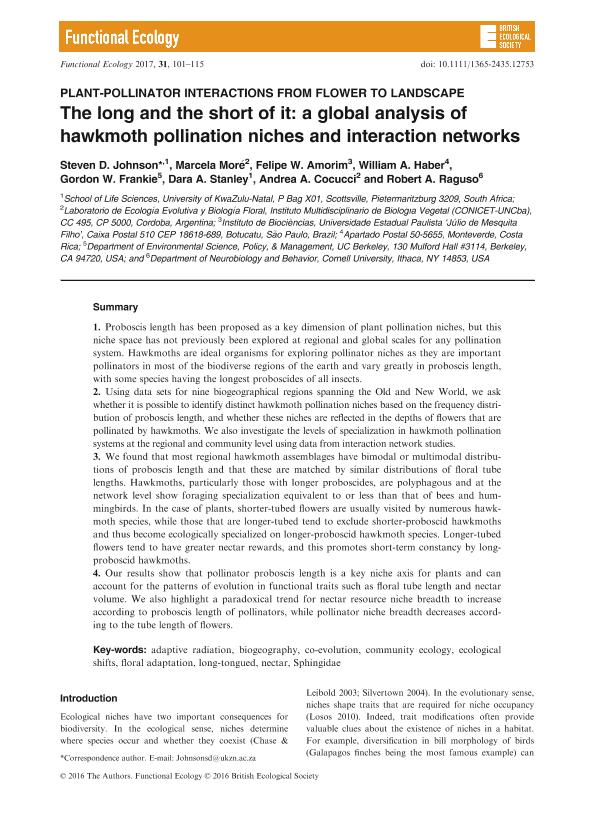Mostrar el registro sencillo del ítem
dc.contributor.author
Johnson, Steven D.
dc.contributor.author
More, Marcela

dc.contributor.author
Amorim, Felipe W.
dc.contributor.author
Haber, William A.
dc.contributor.author
Frankie, Gordon W.
dc.contributor.author
Stanley, Dara A.
dc.contributor.author
Cocucci, Andrea Aristides

dc.contributor.author
Raguso, Robert A.
dc.date.available
2017-09-07T14:51:01Z
dc.date.issued
2017-01
dc.identifier.citation
Johnson, Steven D.; More, Marcela; Amorim, Felipe W.; Haber, William A.; Frankie, Gordon W.; et al.; The long and the short of it: a global analysis of hawkmoth pollination niches and interaction networks; Wiley Blackwell Publishing, Inc; Functional Ecology; 31; 1-2017; 101-115
dc.identifier.issn
0269-8463
dc.identifier.uri
http://hdl.handle.net/11336/23763
dc.description.abstract
Proboscis length has been proposed as a key dimension of plant pollination niches, but this niche space has not previously been explored at regional and global scales for any pollination system. Hawkmoths are ideal organisms for exploring pollinator niches as they are important pollinators in most of the biodiverse regions of the earth and vary greatly in proboscis length, with some species having the longest proboscides of all insects. Using data sets for nine biogeographical regions spanning the Old and New World, we ask whether it is possible to identify distinct hawkmoth pollination niches based on the frequency distribution of proboscis length, and whether these niches are reflected in the depths of flowers that are pollinated by hawkmoths. We also investigate the levels of specialization in hawkmoth pollination systems at the regional and community level using data from interaction network studies. We found that most regional hawkmoth assemblages have bimodal or multimodal distributions of proboscis length and that these are matched by similar distributions of floral tube lengths. Hawkmoths, particularly those with longer proboscides, are polyphagous and at the network level show foraging specialization equivalent to or less than that of bees and hummingbirds. In the case of plants, shorter-tubed flowers are usually visited by numerous hawkmoth species, while those that are longer-tubed tend to exclude shorter-proboscid hawkmoths and thus become ecologically specialized on longer-proboscid hawkmoth species. Longer-tubed flowers tend to have greater nectar rewards, and this promotes short-term constancy by long-proboscid hawkmoths. Our results show that pollinator proboscis length is a key niche axis for plants and can account for the patterns of evolution in functional traits such as floral tube length and nectar volume. We also highlight a paradoxical trend for nectar resource niche breadth to increase according to proboscis length of pollinators, while pollinator niche breadth decreases according to the tube length of flowers.
dc.format
application/pdf
dc.language.iso
eng
dc.publisher
Wiley Blackwell Publishing, Inc

dc.rights
info:eu-repo/semantics/openAccess
dc.rights.uri
https://creativecommons.org/licenses/by-nc-sa/2.5/ar/
dc.subject
Pollination
dc.subject
Hawkmoth
dc.subject
Interaction
dc.subject
Network
dc.subject.classification
Bioquímica y Biología Molecular

dc.subject.classification
Ciencias Biológicas

dc.subject.classification
CIENCIAS NATURALES Y EXACTAS

dc.title
The long and the short of it: a global analysis of hawkmoth pollination niches and interaction networks
dc.type
info:eu-repo/semantics/article
dc.type
info:ar-repo/semantics/artículo
dc.type
info:eu-repo/semantics/publishedVersion
dc.date.updated
2017-08-29T17:31:04Z
dc.identifier.eissn
1365-2435
dc.journal.volume
31
dc.journal.pagination
101-115
dc.journal.pais
Reino Unido

dc.journal.ciudad
Londres
dc.description.fil
Fil: Johnson, Steven D.. University of KwaZulu Natal; Sudáfrica
dc.description.fil
Fil: More, Marcela. Consejo Nacional de Investigaciones Científicas y Técnicas. Centro Científico Tecnológico Conicet - Córdoba. Instituto Multidisciplinario de Biología Vegetal. Universidad Nacional de Córdoba. Facultad de Ciencias Exactas Físicas y Naturales. Instituto Multidisciplinario de Biología Vegetal; Argentina
dc.description.fil
Fil: Amorim, Felipe W.. Universidade Estadual Paulista Julio de Mesquita Filho; Brasil
dc.description.fil
Fil: Haber, William A.. Monteverde; Costa Rica
dc.description.fil
Fil: Frankie, Gordon W.. University of California Berkeley; Estados Unidos
dc.description.fil
Fil: Stanley, Dara A.. University of KwaZulu Natal; Sudáfrica
dc.description.fil
Fil: Cocucci, Andrea Aristides. Consejo Nacional de Investigaciones Científicas y Técnicas. Centro Científico Tecnológico Conicet - Córdoba. Instituto Multidisciplinario de Biología Vegetal. Universidad Nacional de Córdoba. Facultad de Ciencias Exactas Físicas y Naturales. Instituto Multidisciplinario de Biología Vegetal; Argentina
dc.description.fil
Fil: Raguso, Robert A.. Cornell University; Estados Unidos
dc.journal.title
Functional Ecology

dc.relation.alternativeid
info:eu-repo/semantics/altIdentifier/url/http://onlinelibrary.wiley.com/doi/10.1111/1365-2435.12753
dc.relation.alternativeid
info:eu-repo/semantics/altIdentifier/doi/http://dx.doi.org/ 10.1111/1365-2435.12753
dc.relation.alternativeid
info:eu-repo/semantics/altIdentifier/url/https://www.ncbi.nlm.nih.gov/pmc/articles/PMC5363726/
Archivos asociados
